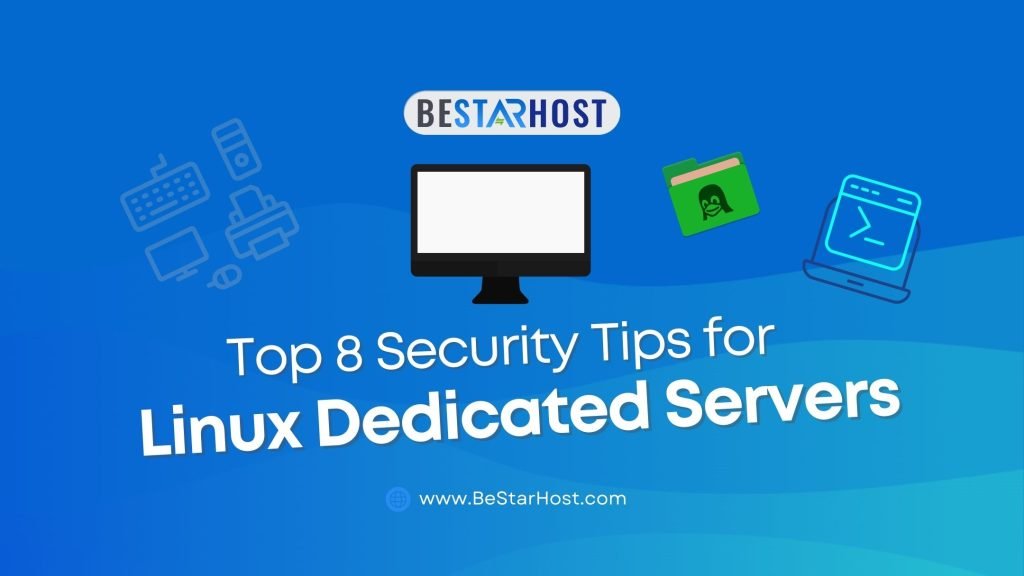
As the backbone of many critical applications and services, Linux servers require robust security measures to protect against threats and vulnerabilities. Securing a Linux dedicated server involves multiple layers of protection, from the initial setup to ongoing maintenance and monitoring. This blog will provide a comprehensive guide with the top 8 security tips to help you harden your Linux server, ensuring it remains secure and resilient against attacks.
1. Keep Your System Updated
Regularly updating your Linux server is one of the most fundamental yet critical aspects of server security. Updates often include patches for security vulnerabilities that could be exploited by attackers.
Key Actions:
- Automate Updates: Use tools like
unattended-upgradeson Debian-based systems ordnf-automaticon Red Hat-based systems to automate security updates. - Regular Checks: Regularly check for updates using package managers (
apt,yum,dnf, etc.) and apply them promptly.
Best Practice: Schedule regular maintenance windows to ensure updates do not disrupt services, and always test updates in a staging environment before applying them to production servers.
2. Configure a Firewall
A firewall acts as the first line of defense by controlling incoming and outgoing network traffic based on predefined security rules.
Key Actions:
- Use UFW or iptables: For Debian-based systems, the Uncomplicated Firewall (UFW) is user-friendly, while
iptablesoffers more advanced configurations. - Define Rules: Create rules to allow only necessary ports and services. For example, allow SSH on a non-standard port, allow HTTP/HTTPS for web servers, and block everything else by default.
Best Practice: Regularly review and update firewall rules to adapt to changing security requirements and to close any unnecessary open ports.
3. Secure SSH Access
SSH is a common entry point for remote server management, and securing it is crucial to prevent unauthorized access.
Key Actions:
- Change Default Port: Change the default SSH port from 22 to something less obvious.
- Disable Root Login: Edit the SSH configuration file (
/etc/ssh/sshd_config) to disable root login by settingPermitRootLogin no. - Use Key-Based Authentication: Disable password-based authentication and use SSH keys instead. Configure this in the SSH config file by setting
PasswordAuthentication no.
Best Practice: Implement two-factor authentication (2FA) for an additional layer of security on SSH access.
4. Implement Intrusion Detection Systems (IDS)
An IDS can help you detect unauthorized access or malicious activity on your server in real-time.
Key Tools:
- OSSEC: An open-source, host-based intrusion detection system.
- AIDE: The Advanced Intrusion Detection Environment monitors changes to files and directories.
Best Practice: Regularly review IDS logs and configure alerting to notify administrators of suspicious activity immediately.
5. Use Strong Password Policies
Weak passwords are a common entry point for attackers. Enforcing strong password policies can significantly reduce this risk.
Key Actions:
- Password Complexity: Require a mix of uppercase and lowercase letters, numbers, and special characters.
- Password Length: Set a minimum password length (e.g., at least 12 characters).
- Expiration and Rotation: Implement policies for regular password changes and avoid reusing old passwords.
Best Practice: Use a password manager to generate and store complex passwords securely.
6. Enable Security-Enhanced Linux (SELinux)
SELinux provides a mechanism for supporting access control security policies, which can enforce mandatory access controls over all processes and files on your system.
Key Actions:
- Enable SELinux: Ensure SELinux is enabled and enforcing policies. Check its status with
sestatus. - Set Policies: Define and implement SELinux policies that restrict access to sensitive files and processes.
Best Practice: Regularly review SELinux logs and adjust policies as needed to balance security with functionality.
7. Regularly Audit and Monitor Logs
Monitoring logs is essential for detecting and responding to security incidents.
Key Tools:
- Logwatch: A log analysis system that summarizes log files for easy review.
- rsyslog or syslog-ng: Tools for log management and forwarding.
Best Practice: Set up centralized logging and use tools like the ELK stack (Elasticsearch, Logstash, Kibana) for log aggregation and analysis.
8. Use Security Tools and Scripts
Leverage available security tools and scripts to automate and enforce security best practices on your Linux server.
Key Tools:
- Lynis: An open-source security auditing tool for Unix-based systems.
- Fail2Ban: Scans log files and bans IPs that show malicious signs, such as too many password failures.
Best Practice: Regularly run security audits and vulnerability scans to identify and remediate potential issues proactively.
Securing your Linux dedicated server is an ongoing process that requires diligence and a multi-layered approach. By following these top 8 security tips—keeping your system updated, configuring a firewall, securing SSH access, implementing intrusion detection systems, enforcing strong password policies, enabling SELinux, regularly auditing and monitoring logs, and using security tools and scripts—you can significantly enhance the security posture of your Linux server.
Remember, the effectiveness of these measures relies on consistent implementation and regular reviews. Stay informed about the latest security trends and vulnerabilities, and continuously adapt your security practices to address emerging threats. With a proactive and comprehensive approach to Linux server hardening, you can protect your server and the valuable data it hosts from potential security breaches.
